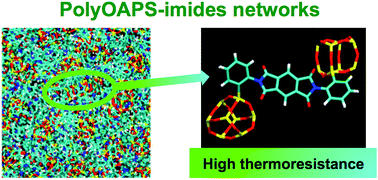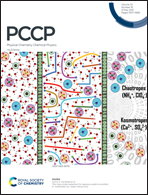High-temperature molecular screening of hybrid polyOAPS-imide networks based on octa(aminophenyl)silsesquioxane for increased thermomechanical resistance†
Abstract
A new family of hybrid hyper-cross-linked thin films based on inorganic polyhedral oligomeric silsesquioxane (POSS) cages covalently bound with short organic imides has recently been developed using interfacial polycondensation followed by high-temperature imidization. These polyPOSS-imide networks were aimed at gas separations under harsh conditions, but the aliphatic arms of the initial POSS precursor, octa(aminopropyl)silsesquioxane, were found to be a weak link. This work investigates the replacement of the aliphatic arm by a phenyl derivative, octa(aminophenyl)silsesquioxane (OAPS). Although this new precursor is expected to be more thermoresistant, it introduces extra degrees of complexity since the functional -NH2 group on the phenyl ring can either be attached at a meta, a para or an ortho position. In order to avoid a costly programme of synthesis and testing, molecular dynamics (MD) simulations have been used to efficiently screen a large number of candidate structures based on mixtures of the three OAPS isomers, the initial POSS and three organic precursors, the PMDA, 6FDA and ODPA dianhydrides. Following cross-linking at room temperature, twenty-two model networks were further relaxed at the imidization temperature and directly tested under harsh conditions at 300 °C. The screening stage included the characterization of their intercage single-links and double-links, which reinforce the structures, and intracage links, which have the opposite effect. Carrying out the cross-linking reactions to completion significantly improved the resistance to isotropic dilation. The initial POSS as well as the flexible 6FDA and ODPA linkers were found to be prone to large deformations, whereas the orthoOAPS, metaOAPS, paraOAPS and the PMDA linker prevented volume dilations. Upon uniaxial tension, the Young's moduli varied in the order paraOAPS < POSS ≈ metaOAPS < orthoOAPS for the inorganic precursors and in the order 6FDA < ODPA < PMDA for the organic precursors. In all cases, the networks based on either orthoOAPS and/or PMDA displayed superior resistance. Nine polyOAPS-imides were further heated up to 400 °C, i.e. closer to the expected degradation, and re-submitted to isotropic dilations and uniaxial tensions. They confirmed the trends found at 300 °C with no signs of structural collapse. Using OAPS as the inorganic precursor thus significantly reinforces the thermoresistance of these hybrid hyper-cross-linked networks.



 Please wait while we load your content...
Please wait while we load your content...